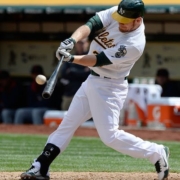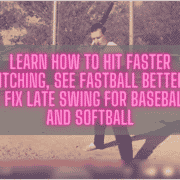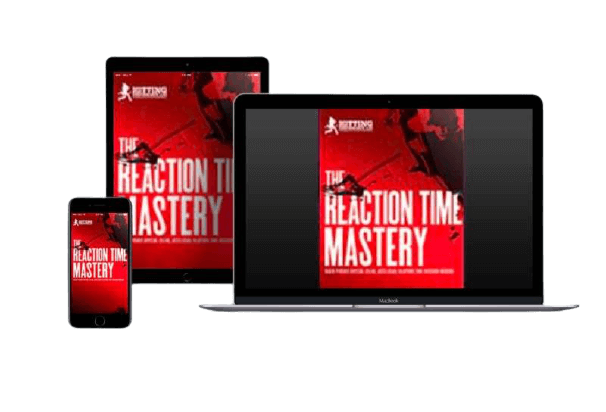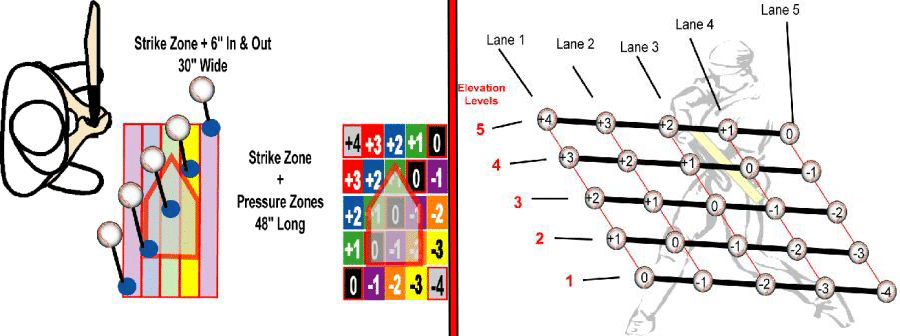Discover how to hit slow pitching, improve batting timing and rhythm mechanism, and STOP swinging early. For beginner baseball and softball players. Learn simple drills and tips for better more on-time hitting…
Brandon Moss Swing Analysis REVEALS Slow Pitcher Timing Secret
This Brandon Moss analysis comes from a conversation I had with Coach Justin Karr and his 12-U Bakersfield Sliders Black team. Thanks Coach Karr, I hope this helps your troops!
I want to compare what Brandon Moss does differently hitting a slower pitcher, like knuckle-baller R.A. Dickey of the Toronto Blue Jays, to a hard throwing “King” Felix Hernandez of the Seattle Mariners. We’re going to:
- Make the complicated, uncomplicated,
- Learn how-to adjust to slower pitching according to Brandon Moss, and
- Discuss what a hitter can do to adjust timing.
Make the Complicated, Uncomplicated
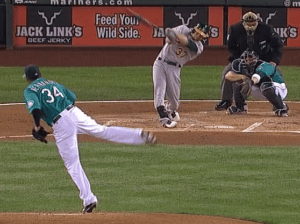
Brandon Moss photo courtesy: MLB.com
First of all, executing flawless hitting mechanics mean nothing if timing is off. I love how Dr. Kelly Starrett describes learning complicated movements (or strategies) in his book Becoming A Supple Leopard: The Ultimate Guide to Resolving Pain, Preventing Injury, and Optimizing Athletic Performance:
“When it comes to learning complicated movements efficiently, the key is to make them uncomplicated. We do this by breaking them down into precise, manageable steps. Then we emphatically encourage like-your-life-depends-on-it focus in performing each step. This is the path to a tight learning curve. It’s the foundation required for optimal performance.”
We focus on one aspect at a time. In respect to the calibration of timing, we have to forget swing mechanics and focus solely on adjusting the timing. Making in-game adjustments, timing is THE most important priority. We teach three possible swing adjustments with our seven hitting strategies. We refer to these as the three dimensional hitting adjustments:
- Timing – is hitter out front or behind?
- Vertical (Launch Angle) – did hitter hit popup or ground-ball (or line drive?), and
- Horizontal (Barrel Path) – did hitter get jammed or hit ball off the end?
Which one of these after an in-game swing, if tweaked, fixes the other two?
SCIENCE-BASED TRAINING:
Improve your hitting strategy dramatically by applying human movement principles.
Learn not only how and what to train but also the science behind the methods.
How-To Adjust to Slower Pitching According to Brandon Moss
In the video, I compare and analyze two 2013 home-run swings by the Oakland A’s first baseman Brandon Moss:
- 77 mph knuckle-ball from R.A. Dickey Moss (left-handed) hit over the center field fence (418 feet*), and
- 93 mph fastball from “King” Felix Hernandez Moss hit over the right-center field fence (387 feet*)
(*You can find out more home-run stats at BaseballSavant)
CLICK HERE to revisit a video blog article I did, featuring Josh Hamilton and Mike Trout, where I went over:
- When does a swing start?
- Leg kick or slide step? and
- How to practice timing?
For an average velocity pitcher, each hitter MUST figure out at what point in the pitcher’s delivery that they start their swing. Then experiment starting the swing at a later point with a slower pitcher. This will be slightly different for every hitter as the Josh Hamilton article shows.
The main point is, the hitter has to make a a conscience effort to change their timing. They can’t just use the same timing for every pitcher. Hitting is a game of inches…being one inch ahead or behind can mean barreling the ball or not.
What’s the best way to practice this? The 2-plate drill shared in this article, and home run derby?? Using the 2-plate drill and throwing seated from 25-30 feet away (under or over hand front toss). The thrower will be literally lobbing the ball to the hitter as they take two swings and switching plates. Six swings per round. The slower the throw, the better. In our system, this is hitting strategy number 4.
Also, if the whole team’s offensive numbers are suffering against a slower pitcher, then the adjustment DOES NOT necessarily have to be a mechanical one.
One more interesting point…notice how far Brandon Moss cranked the Dickey knuckle-ball? 418 feet!! “King” Felix? 387 feet…a pitcher’s velocity doesn’t dramatically contribute to batted ball distance. It’s bat speed that does. According to a forum at eFastball.com, for every 1 mph of added pitching velocity, 1 foot of batted ball distance is the outcome. BUT for every 1 mph of increased bat speed, 4 feet of batted ball distance is the result!! Don’t let low velocity pitchers slow your bat speed down hitters!

